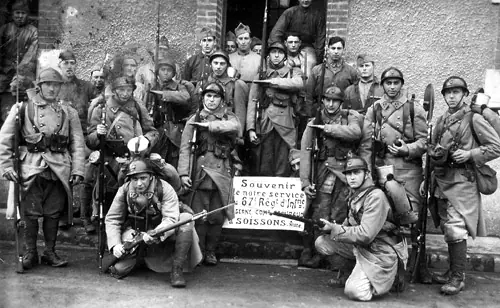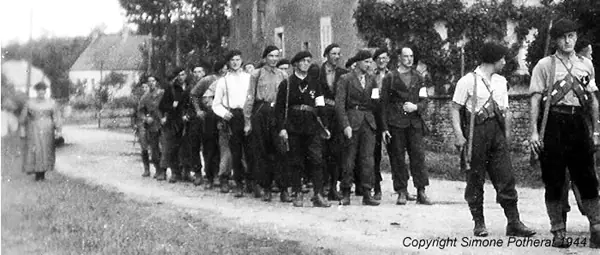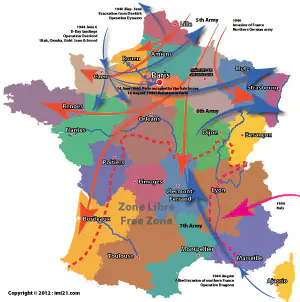The Second World War in France
On the 3 September 1939 France and Great Britain declare war against Germany, after the invasion of Poland.
France plunged into a dark age, occupied by the Nazis with the terrible implications bombing raids, executions, deportation, murders and famine. Slowly the resistance took shape and began to react, but against such a foe little changed. The population waited for liberation, living day by day under the control of an iron fist imposed by the collaboration of the Vichy government, the SS and Gestapo.
Freedom came with the arrival of the Allied Forces and the D-Day landings in Normandy, the French reacted to the calls of their self-exiled leader Charles de Gaulle. However, the effort to push the Germans back to the river Rhine was still long and heavy on victims.
Read more articles...
The French Resistance in World War II, a real-life story about events in a small village

French soldiers from the 67th Infantry Regiment ( 67e régiment d'infanterie ). Soissons is only where it was garrisoned then disbanded in 1993. Since the end of the Ancient Régime, no regiments used "location name" ( such as the Gloucestershire Regiment etc ). It was once named 67e Demi-Brigade de Bataille or 67e Regiment d'Infanterie de Ligne but never Soissons something. The date is based on the uniform and weapons (thank you Jean Fallay). Event map of World War 2
Events during 1940
10th May: It is the beginning of the Battle of France. The Battle of France is used to describe the invasions of the Netherlands, Belgium, Luxembourg and then France by the German army. Putting an end to the Phoney War, the Battle of France saw in the following months the retreat of the British troops and the fall of France.
27th May to 4 June: Operation Dynamo, the Evacuation of Dunkirk, more than 300,000 French and British soldiers were evacuated by boats of all types from the beach. Around 40,000 soldiers, most of them French were killed or captured.
16th to 24th June: Operation Ariel and Operation Cycle, more than 150,000 Allied soldiers evacuated from the ports of Cherbourg, St. Malo, Brest, St. Nazaire, La Pallice, Nantes and Le Havre.
14th June: Paris is occupied by Axis forces.
16th June: Pétain becomes the leader of France.
18th June: General de Gaulle calls the French to begin resistance against the Germans in a broadcast made from London on the BBC.
24th June: France officially surrenders to Germany.
25th June: The German advance is halted and France is divided into two regions, The "Zone libre" is placed under the command of French General Pétain, a puppet, acting on behalf of the Nazis.
10th July: what is left of the French government hand over all powers to General Pétain, this is the end of the Third Republic in France, which was now a "State".
3rd October: Publication of the "premier Statut des Juifs", banishing Jews from civil, commercial or industrial functions and public positions.
4th October: The law concerning " Jewish foreigners " is proclaimed and authorizes the immediate internment of foreign (non-French nationals) Jews.
Events during 1941
Autumn 1941, 10000 French join the "Forces Françaises Libres". This fighting force was not only built by French men but also, men from Senegal, Chad, Cameroon, Algeria, Morocco and Tunisia.
The "FFL", were placed under the orders of General Leclerc and his 2nd Armed Division "2eme Division Blindée".
Events during 1942
7 May: The STO (Service du travail obligatoire which means "Obligatory Work Service") begins. Throughout German-occupied Europe, young men are called to participate in the war effort. The German powers demand France provide 250 thousand volunteers before the end of July.
In June, Pierre Laval (leader of the French government) succeeds in negotiating a deal, where 3 volunteers for the STO for one war prisoner. This system fails with only 17 thousand volunteers.
On the 22nd of August the German powers impose forced recruitment of both men and women in an attempt to reach the 250 thousand. At first, concerned only the Occupied France, however, Pierre Laval arranged for this to become French Law. This meant that all French citizens were concerned which included "Zone Libre" ( the Free French Zone).
18 -50 men, 21-35 single women. In December, the objective of 250 thousand workers is attained.
16 July: 12,884 non-French Jews in Paris are taken to the Vélodrome d'Hiver and then sent to the concentration camps.
November: The "Zone Libre" is occupied by the Axis.
13 April: Jean Moulin, the most important figure of the French Resistance is parachuted into France. He dies after months of torture by the Nazis on a train whilst being transported to Germany in 1943.
Events during 1943
January: The German powers demand another 250 thousand workers form the STO from France.
April: 120 thousand required for May, and another 100 thousand for the month of June.
6 August: 500 thousand workers are demanded by the Germans, but these numbers are never achieved as there are too many opponents and refusals. So the Germans put an end to the STO, however, an agreement is found with the French government, where the workers are protected but the French companies become integrated within the German economy.
During the summer of 1943, there is a surge to join the Maquis / French resistance and avoid forced labour. Unofficial figures mention 200 thousand people being taken away for the forced labour with 50 thousand escaping, many of whom join the resistance. More than 30 thousand escaped France into Spain or North Africa and joined the FFA. For those who did not want to fight or find a place" in the resistance, they remained hidden at home or in isolated farms with the help of accomplices. Certain people were simply forgotten as the German bureaucracy was submerged in paperwork.
Events during 1944
As France begins to be liberated by the Allied forces, more than 2 million French people are still in German.
2 April: ASCQ Near the city of Lille 70 killed
6 April: Outrage AT IZIEU Central France capture of young Jewish killed all deported
21 May: The massacre of Frayssinet near Tulle, Central France, 15 people killed
5 June: Paratroopers of the 82nd and 101st Airborne Divisions lauch attack on Sainte-Mère l'Eglise
6 June: D-Day landings, Operation Overlord begins with Allied landings on the beaches Silver Utah Gold
9 June: The Tulle Murders near Limoges, Central France, the SS murdered 99 men.
10 June: Oradour-sur-Glane 2nd Waffen SS Panzer Division Das Reich, drove into the village of Oradour and killed everyone they could find, a total of 642 men, women and children, with only 6 people escaping. Many of the victims were locked into a church and burnt alive.
26 June: Cherbourg liberated by American troops.
9 July: Caen is liberated by the Allies.
15 August: Operation Dragoon: landing in Provence
18 August: Liberation of Paris begins and ends 25 August 1944
12 September: Liberation of Dijon
19 September: Nancy liberated by US First Army.
30 September: German garrison in Calais surrenders to Canadian troops.
24 November: Strasbourg liberated by French troops.
16 December 1944: Battle of the Bulge
The end of the war in Europe
1945 Capitulation of Germany and the signature of the Armistice in Reims, which marks the end of the Second World War in Europe.
War graves
For information regarding military cemeteries and graves of Allied soldiers, please visit the Commonwealth War Graves Commission Commonwealth War Graves Commission

French resistance members from a "Maquis" in the Morvan (central-eastern France).

French Resistance walking through a village in a "show of force" after the war has finished.
Interesting places and memorials to visit
Normandy Region :
D-Day of the Allied Landings and battles to liberate France are conserved in a museum./p>
The city of Caen which was destroyed at almost 70% and then liberated by the Canadian forces has many memorial places with guided tours of the landing beaches, the artificial port of Arromanches and museums.
In the Lower-Normandy region, the department of Calvados you will find the Normandy American Cemetery and Memorial. With its 70 hectares, several personalities are buried there like President Theodore Roosevelt's elder son, Theodore Roosevelt Junior.
Lorraine region
The department of the Moselle, in the Lorraine region transformed the concentration camp of Natzwiller-Struthof into a life-sized museum, which is unique in France.
Limousin region
The tragic village of Oradour-sur-Glane which suffered atrocities is now a living open-air memorial. In June 1944, the entire population of the village was executed by the Das Reich SS Division. Men were shot in the legs then burned whilst the women locked in the church which was then burnt. One woman escaped the church, although wounded by a bullet she managed to hide. Later she was the only person able to explain what happened in this small and ordinary quiet village.
Today, the village lays still as if only a few minutes have passed by since the killings, nothing was changed or moved. During the visit, you can still see bullet holes in different places, the wrecked car and the melted bell of the church laying on the ground. A ghost village and a very emotional place to be.
More information
- Statistics about the war
- American D-Day : Dedicated to young Americans, who fought in Omaha Beach, Utah Beach, and the Pointe du Hoc.
- D Day, 6 June 1944 : One of the best websites that we have listed, much research and information about the Normandy invasion and World War II. Please visit.
- Hell On Wheels U.S. ARMY 2nd ARMORED DIVISION SITE
